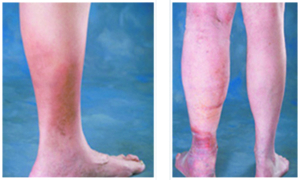We often are asked by referring providers to see patients with red sores and/or a skin rash on the leg. In these cases the patients will often ask: Is it possible that red itching rash by my ankle is related to my varicose veins? And if so, does treating the varicose veins can improve the rash?
 The answer to both questions is YES.
The answer to both questions is YES.
How Can Veins Cause Red Sores & Skin Rashes?
The medical term for varicose veins in venous insufficiency. Venous insufficiency can be a progressive issue for some patients over time. What can start as just a few bulging soft varicose veins in the lower legs can progress to skin discoloration by the ankles and lower calf. Sometimes its just a little redness. Other times it can be a red, itchy and/or burning rash.
When vein skin becomes inflamed and itches, it is called “stasis dermatitis.” Some have referred to this as gravitational eczema. In this case, stasis refers to pooling blood in the varicose veins and dermatitis means inflammation of the skin. A big part of this is ankle swelling, where the skin may crack and this can contribute to the stasis dermatitis.
Lower Leg Skin Rashes and Varicose Veins
One the problem is recognized its important to consider the diagnosis and treatment options. There are lots of reasons patients can have rashes and skin issues, so if there is ever a question, we advise seeing a dermatologist who can help sort this out. But in many cases, we find treating the veins helps a lot.
The first step is usually compression. This helps squeeze out the extra fluid that is cracking the skin. After a week or so of compression every day a lot of times the skin will start to heal. Topical lotions can help at this point as well. Ultimately the patient may benefit from treating the patient’s varicose veins with techniques such as Closurefast RFA or Venaseal. This can have a profound effect in the right patients to help the skin heal and the itching improve.
 A particularly troubling complication for patients with a lot of leg swelling by the ankle occurs when the skin cracks and gets infected. This can lead to a complication called cellulitis. This can be life threatening, or require a hospital stay and antibiotics. A critical piece in preventing this, or treating this when it occurs is compression. If there are no open wounds simple compression stockings can go a long way to getting the swelling down to a minimum so the skin can heal.
A particularly troubling complication for patients with a lot of leg swelling by the ankle occurs when the skin cracks and gets infected. This can lead to a complication called cellulitis. This can be life threatening, or require a hospital stay and antibiotics. A critical piece in preventing this, or treating this when it occurs is compression. If there are no open wounds simple compression stockings can go a long way to getting the swelling down to a minimum so the skin can heal.
Don’t Let Skin Rashes & Sores Go Untreated
Without treatment, in some patients, especially over time, the skin can become hard and brown. This is called Lipodermatosclerosis….or LDS. This is a hardening of the skin and underlying tissues from chronic scarring from the high venous pressures in the varicose veins.
Specialty vein treatment can be quite helpful for these patients. For example, when compression and some form of vein ablation (like Closurefast or Venaseal or Varithena), along with treatment of the branch varicose veins, the skin will often heal and the symptoms of itching and irritation will improve. In this video interview, Inovia Vein’s Dr. Boyle explains how this happens.
Occasionally these rashes or wounds are not entirely venous based. In these cases, multi-disciplinary collaboration between the vein clinic and the referring providers, dermatologist or wound specialists can be helpful.
Evaluate a Vein Skin Rash
If you have a red, irritated patch or patches of skin by your ankles and varicose veins, consider a vein consultation at one of our offices in NW Portland, Tigard, Happy Valley, Hillsboro or Bend, Oregon to learn more about your treatment options.

 In some cases the skin can break open and not heal, known as a venous stasis ulcer. This too can be a very painful, debilitating problem. Once this occurs, treatment can still help. For example, when patients have venous stasis ulcers treatment with compression and some form of vein ablation (like
In some cases the skin can break open and not heal, known as a venous stasis ulcer. This too can be a very painful, debilitating problem. Once this occurs, treatment can still help. For example, when patients have venous stasis ulcers treatment with compression and some form of vein ablation (like